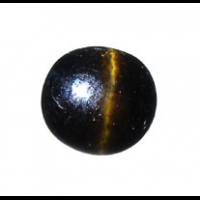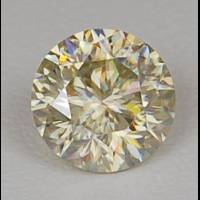Rutile

Sri Lanka
4.77 carats
Golden-coloured rutile typically occurs in a slender acicular form. The small needles of rutile found in gems cause an optical phenomenon known as asterism. Asterated gems are known as "star" gems (Star sapphire, Star rubies, etc.).
Rutile has high refractive index and strong dispersion, it gives an adamantine lustre and a diamond-like appearance to its crystals.
Rutile crystals frequently form as elbow or cyclic twins.
Rutile Gemstones by Colour
This table shows the variety of hues this gemstone can be found in. Click on a photo for more information.
Rutile Gemstones by Size
This table shows distribution of Rutile gemstone sizes that are listed on this site. This can give a good indication as to the general availability of this gemstone in different sizes.
Contributed photos
Lightest:0.96 cts
Heaviest:4.77 cts
Average:2.48 cts
Total photos:5
Do you have a larger Rutile? Why not upload a photo?
| General Information | |||||||||||||||||||||||||||||||||||
|---|---|---|---|---|---|---|---|---|---|---|---|---|---|---|---|---|---|---|---|---|---|---|---|---|---|---|---|---|---|---|---|---|---|---|---|
| Chemical Formula |
| ||||||||||||||||||||||||||||||||||
| Rutile Treatments | |||||||||||||||||||||||||||||||||||
| Pale yellow, synthetic rutile may be turned an attractive blue color by heating at over 1000°C in a reducing atmosphere. Heating at 1000°C in oxygen reverses this change (Nassau, 1980) - Nassau (1984) | |||||||||||||||||||||||||||||||||||
| Synthetic Rutile | |||||||||||||||||||||||||||||||||||
| Synthetic rutile: Colourless, yellowish, Transparent; Hardness 6 - 6.5; RI 2.616 - 2.903; Birefringence 0.287; Uniaxial/+; SG 4.26; Inclusions: occasionally gas bubbles - Gemmological Tables, Ulrich Henn and Claudio C. Milisenda, 2004, p 31 | |||||||||||||||||||||||||||||||||||
| Physical Properties of Rutile | |||||||||||||||||||||||||||||||||||
| Mohs Hardness | 6 to 6.5, Blue Chart Gem Identification (2010) More from other references | ||||||||||||||||||||||||||||||||||
| Specific Gravity | 4.20 to 4.30, Blue Chart Gem Identification (2010) More from other references | ||||||||||||||||||||||||||||||||||
| Cleavage Quality | Distinct, Gemmological Tables (2004) | ||||||||||||||||||||||||||||||||||
| Fracture | Sub-Conchoidal, Gemstones (2009) | ||||||||||||||||||||||||||||||||||
| Optical Properties of Rutile | |||||||||||||||||||||||||||||||||||
| Refractive Index | 2.609 to 2.903, Blue Chart Gem Identification (2010) More from other references | ||||||||||||||||||||||||||||||||||
| Optical Character | Uniaxial/+, Blue Chart Gem Identification (2010) More from other references | ||||||||||||||||||||||||||||||||||
| Birefringence | 0.287, Blue Chart Gem Identification (2010) DoublingMore from other references | ||||||||||||||||||||||||||||||||||
| Pleochroism | Strong, Gemstones (2009) | ||||||||||||||||||||||||||||||||||
| Dispersion | Very high, Blue Chart Gem Identification (2010) More from other references | ||||||||||||||||||||||||||||||||||
| Chatoyancy | Yes, star 4, Blue Chart Gem Identification (2010) | ||||||||||||||||||||||||||||||||||
| Colour | |||||||||||||||||||||||||||||||||||
| Colour (General) | (Dark) yellowish brown, reddish brown, black, Blue Chart Gem Identification (2010) More from other references | ||||||||||||||||||||||||||||||||||
| Causes of Colour | Blue (synthetic rutile), Band transition due to the presence of Ti3+, Pragmatic Spectroscopy For Gemologists (2011) | ||||||||||||||||||||||||||||||||||
| Transparency | Transparent,Translucent,Opaque, Gemmological Tables (2004) | ||||||||||||||||||||||||||||||||||
| Lustre | Adamantine,Metallic, Gems, Sixth Edition (2006) | ||||||||||||||||||||||||||||||||||
| Fluorescence & other light emissions | |||||||||||||||||||||||||||||||||||
| Fluorescence (General) | Inert, Blue Chart Gem Identification (2010) | ||||||||||||||||||||||||||||||||||
| Crystallography of Rutile | |||||||||||||||||||||||||||||||||||
| Crystal System | Tetragonal, Blue Chart Gem Identification (2010) More from other references | ||||||||||||||||||||||||||||||||||
| Habit | slender prismatic striated lengthways, variably terminated and often geniculate twinned crystals, Gems, Sixth Edition (2006) | ||||||||||||||||||||||||||||||||||
| Geological Environment | |||||||||||||||||||||||||||||||||||
| Where found: | Rutile occurs as a common high-temperature, highpressure accessory mineral in igneous rocks and granite pegmatites and in regionally metamorphosed rocks including crystalline limestones. Rutile needles are common inclusions in a number of gem minerals., Gems, Sixth Edition (2006) | ||||||||||||||||||||||||||||||||||
| Further Information | |||||||||||||||||||||||||||||||||||
| Mineral information: | Rutile information at mindat.org | ||||||||||||||||||||||||||||||||||
| Significant Gem Localities | |||||||||||||||||||||||||||||||||||
| |||||||||||||||||||||||||||||||||||


